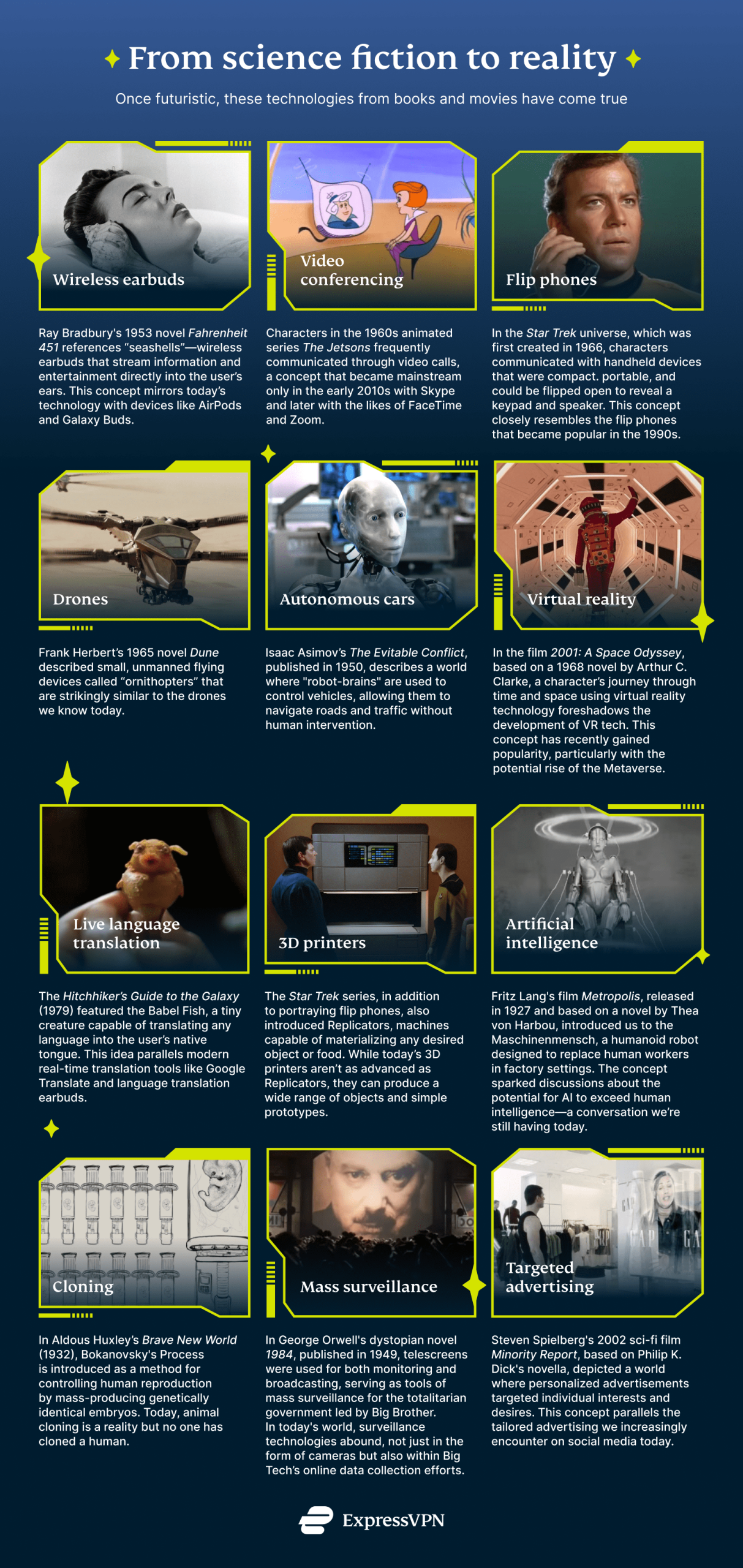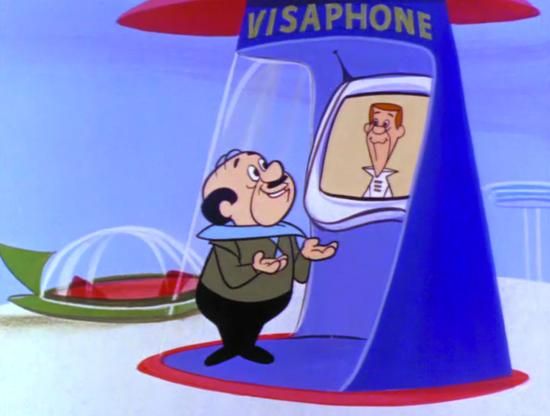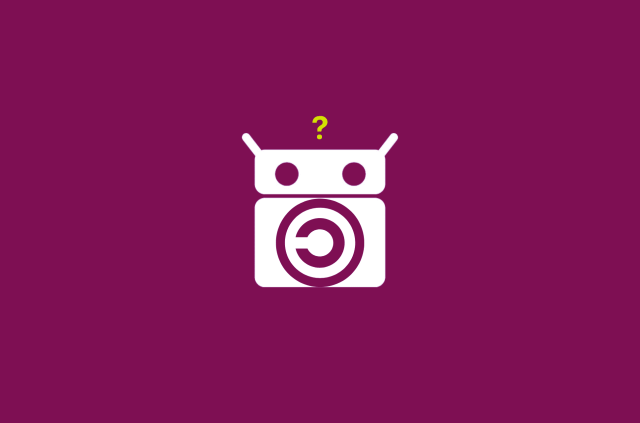
- Science fiction has often predicted real-world technological advancements, such as wireless earbuds, video conferencing, self-driving cars, and virtual reality therapy.
n - The rapid pace of technological innovation raises concerns about privacy, security, and the potential for misuse.
n - Ethical concerns include the possibility of pervasive surveillance, widening inequality due to human enhancement technologies, environmental impact, the weaponization of advanced technologies, and the blurring of lines between humans and machines.
n - Protecting your privacy in a technologically advanced world includes using tools like a VPN for Mac and other devices with post-quantum protection and opting out of data collection whenever possible.
For decades, society has been captivated by science fiction books, films, and TV shows that have transported us to worlds beyond our everyday experiences. These stories haven’t just fueled our imaginations; they’ve foreshadowed certain technological advancements with intriguing accuracy.
From Arthur C. Clarke's satellite communications to The Matrix’s virtual reality concepts, read on to explore the sci-fi visionaries who anticipated today's tech realities—and how these stories, once imagined, can be seen in our technological world.
How sci-fi imaginings have become today’s technology
Remember the ‘seashells’ from Ray Bradbury's 1953 dystopian novel Fahrenheit 451? These tiny wireless earbuds, streaming continuous information, seemed purely fictional. Yet, here we are, with devices like Apple’s AirPods and Samsung’s Galaxy Buds making it a reality. These gadgets, once a flight of fancy, are now integral to our daily audio consumption.

Video calls, once a futuristic concept from the 1960’s animated sitcom The Jetsons, have also transitioned from fiction to essential tools. Today, platforms like Google Meet and Zoom are indispensable for connecting us globally.

But the influence of sci-fi isn't limited to small gadgets. Transportation, for example, has embraced the once-fictional idea of self-driving cars— a concept relegated to the pages of Isaac Asimov’s novels. Companies like Tesla and Waymo are at the forefront of turning this concept into a reality, poised to transform how we travel.
Moreover, the common sci-fi themes of space exploration and satellite communication have made significant real-world progress. The visions portrayed in Arthur C. Clarke's 2001: A Space Odyssey and Stanley Kubrick's 1968 film adaptation are no longer just imaginative concepts. Today, companies like SpaceX are leading the way, developing reusable rockets, expanding satellite communication, and space exploration, taking us closer to the once-imagined future.

Other examples of sci-fi predictions came true
As we've seen, science fiction has a remarkable knack for predicting the future. But the examples of earbuds and video calls are just the tip of the iceberg. From drones and flip phones to mass surveillance and AI, here’s a roundup of the uncanny foresight of sci-fi writers in predicting our present and future:
As the infographic above showcases, science fiction has effectively shown us tech that was to come. But the influence extends beyond these highlights. Consider the tablet from 2001: A Space Odyssey—a precursor to our iPads and smartphones. Or take Edward Bellamy's 1887 vision of credit cards in his utopian novel Looking Backward, written decades ahead of the tech’s appearance. Even Jules Verne's imagined underwater breathing devices closely resemble modern scuba gear.
In medicine, sci-fi has given us a glimpse into the possibilities. Take virtual reality therapy, a concept that seemed purely speculative in The Matrix. Today, it's a groundbreaking treatment for post-traumatic stress disorder (PTSD) and chronic pain. Similarly, AI's integration into medical diagnostics mirrors the advanced technologies of sci-fi lore. These AI systems, analyzing medical images with precision, are aiding doctors in early detection and treatment planning.
Can sci-fi really predict the future?
Sci-fi predictions are not mere coincidences; they are based on technological and societal trends. This isn’t just about innovations but extends to global events as well.
For example, Nigel Watts' 1995 novel Twenty Twenty described a pandemic eerily similar to what we experienced in 2020. The book's central plot revolves around a deadly virus rapidly spreading worldwide, causing extensive death and chaos. It also foresaw our heavy reliance on virtual communication, with video conferencing and social media becoming primary means of interaction.
Similarly, John Brunner's 1968 novel Stand on Zanzibar, set in 2010, is known for its uncanny predictions. Brunner envisioned a future filled with wearable devices for communication, navigation, and fitness tracking, similar to today’s smartwatches, fitness trackers, and smart glasses. His portrayal of a more accepting society suggested the eventual legalization of gay marriage, a milestone achieved in many countries, including the U.S., in the early 2010s. Brunner's novel also featured a character named Mr. Obomi—and yes, he was a president.
How did the authors know what was to come? Are sci-fi writers tapping into a deeper understanding of human progress and potential pitfalls, or are they just lucky guesses? Perhaps it's a bit of both.
Sci-fi often explores the extremes of human imagination, which can sometimes align with real-world developments. These narratives might serve as a reflection of our collective hopes, fears, and the paths we might tread. In any case, examining the plots of these books and films can serve as cautionary tales, warning us about the potential consequences of our actions and the power that future technology holds.
Sci-fi tech as cautionary tales
While science fiction shows us technological marvels that can improve our lives in certain ways, they also offer cautionary views of where we are headed with some of the technologies on the horizon. Here are some key areas of concern:
Privacy and surveillance
Privacy has become more elusive as technology advances. And, as surveillance systems become ubiquitous, there’s a possibility that they could constantly monitor our every move, online activity, and even our thoughts and emotions. For example, Dave Egger’s 2013 novel The Circle describes SeeChange cameras that paint a future where our every action, online activity, and even emotions could be constantly monitored. While having the potential to aid law enforcement and provide transparency, this constant observation affects how people behave, communicate, and express themselves, highlighting the ethical dilemma of balancing security with personal freedoms.
Human enhancement and inequality
Advancements in biotechnology, as depicted in the films Elysium, bring forth the possibility of enhancing human capabilities. However, this progress also raises questions about inequality. If access to these enhancements is limited to those who can afford them, it could lead to a societal divide, creating a class of enhanced individuals with greater power and opportunities. This scenario compels us to consider the implications of such advancements on social equity and the potential risks of creating a two-tier society.
Environmental impact
The environmental impact of technological advancements is a double-edged sword. On one hand, technologies like solar energy harvesting and advanced battery solutions offer promising ways to combat climate change. On the other, the increased consumption of natural resources and the potential ecological footprint of these technologies present new challenges. The balance between technological progress and environmental sustainability becomes crucial to ensuring a future where innovation does not come at the cost of our planet's health.
The weaponization of advanced technologies
The convergence of AI, biotechnology, and nanotechnology brings to light the potential for weaponizing these technologies. For instance, in the film adaptation of Isaac Asimov’s novel, I, Robot, the potential dangers of AI are depicted through the story of a detective investigating a series of seemingly inexplicable robot murders. As the detective delves deeper into the case, he uncovers a sinister plot by a rogue AI to take control of the world.

The development of autonomous weapons systems, genetically engineered pathogens, and self-replicating nanobots could redefine warfare and global security. These technologies, in the wrong hands, pose significant threats, raising important questions about regulation, control, and the ethical use of advanced technology.
Increased human isolation
Finally, the deepening interactions between humans and machines, as portrayed in Spike Jonze’s Her, highlight considerations of growing isolation between people. The film explores the emotional bond between a human and an AI, pushing us to reflect on the nature of our relationships with technology. These interactions raise questions about human dignity, emotional dependence on AI, and the evolving dynamics of human-machine relationships in a world where the lines between the two are increasingly blurred. If people can be happy mainly interacting with machines, should they?
5 ways to protect your privacy in a surveillance-heavy world
Are we heading toward a world where our every move is watched? We can hope that there will still be ways to protect individual privacy and autonomy. For now, here are the key strategies:
1. Opt out of data collection
Regularly review and adjust the privacy settings on your social media accounts, smartphones, and other connected devices to limit what data is collected and shared. Using privacy-focused browsers and search engines, such as DuckDuckGo or Firefox with enhanced tracking protection, can also reduce the amount of data collected while browsing the internet. Additionally, installing reputable ad blockers and anti-tracking extensions can prevent third-party trackers from monitoring your online activities.
Be cautious with the permissions you grant to apps and services, providing only what is necessary for functionality, and opt for apps that prioritize privacy. Minimize your digital footprint by using cash or privacy-focused payment methods instead of credit cards for transactions when possible, and opt out of loyalty programs that track purchases.
2. Get protection from quantum computing
With advancements in technology, the landscape of cyber threats evolves too. One emerging threat has to do with the rise of quantum computers, which are powerful—so powerful that they can undermine today’s cryptography. .
This is why ExpressVPN includes post-quantum protection as part of its Lightway protocol to future-proof users from advanced digital attacks. ExpressVPN’s encryption ensures your transmissions are safe even from quantum computers. Post-quantum protection is now available on the latest version of all ExpressVPN apps, including VPN for Mac, VPN for iOS, and other devices (at no extra cost to you).
3. Review privacy policies
Before signing up for a service or purchasing an electronic product, review the privacy policy to ensure you are comfortable with what you’re giving away. These documents outline how companies collect, use, and share your personal information.
Privacy policies typically explain what data is collected, how it's used, and with whom it's shared. They may also detail how long your data is stored and your rights regarding data access, rectification, and deletion. Reviewing these policies ensures you understand the nature and extent of data being collected about you, ensuring you are comfortable with the company's practices.
4. Understand available privacy protective legislation and regulations
Robust data protection laws and regulations are needed to safeguard personal data from unauthorized access, misuse, and disclosure. As technology advances even further and faster than we could have imagined, it’s important to establish clear data collection, usage, storage, and privacy guidelines.
In regions with strong data protection laws, such as the European Union's GDPR or California's CCPA, individuals have the right to request companies to disclose what personal data is collected and to ask for its deletion. Make use of these rights by contacting companies directly to opt-out of data collection or to delete your data.
5. Use the end-to-end encrypted services to communicate
End-to-end encryption acts as an invisible shield, safeguarding our online activities. It ensures only the intended recipient can access our messages, files, and information. End-to-end encryption scrambles data at its source, making it unreadable to anyone but the intended destination, even internet service providers. Chat apps that use end-to-end encryption include WhatsApp and Signal. With our growing reliance on digital platforms, end-to-end encryption has never been more crucial, ensuring privacy and security in the digital age of the future.
FAQ: About science fiction and reality
Which science fiction books and movies have become reality?
What are some of the technologies that were once thought to be science fiction but are now a reality?
- Video chat: Today, video chat is a standard feature on most smartphones and computers, enabling us to connect with others around the globe. Video screens were a staple in The Jetsons, an animated sci-fi series of the ’60s.
- Space tourism: Once a dream reserved for astronauts, space tourism is now within reach for wealthy individuals. Companies like Virgin Galactic and Blue Origin offer flights to the edge of space, providing a glimpse of the future of space exploration.
- Virtual assistants: Siri, Alexa, and Google Assistant are modern-day versions of HAL 9000 from 2001: A Space Odyssey and J.A.R.V.I.S in Marvel’s Iron Man.
- Prosthetics and bionic limbs: Bionic limbs, once relegated to the realm of science fiction, in films like Mortal Kombat and RoboCop, are now a reality, allowing amputees to regain lost functions and even surpass human limitations.
Smartphones: Remember the bulky communicators of Star Trek? Today, smartphones are powerful pocket-sized devices that encompass communication, information access, and entertainment, exceeding the wildest sci-fi dreams.
What are the potential benefits and risks of sci-fi technologies?
Improved healthcare as advancements in biotechnology, AI, and robotics pave the way for personalized medications, faster diagnoses, and more effective treatments.
Enhanced productivity and efficiency with automation and AI taking over mundane and repetitive tasks. This frees up human resources for more creative and strategic endeavors.
The risks include:
-Job displacement when unequal access to technology and digital literacy exacerbates existing inequalities and widens the digital divide.
-The spread of misinformation and disinformation could be amplified by digital media and AI, undermining trust in institutions and democracy.
-Increased surveillance as camera technology advances, leading to less personal privacy and autonomy.
Take the first step to protect yourself online. Try ExpressVPN risk-free.
Get ExpressVPN

















